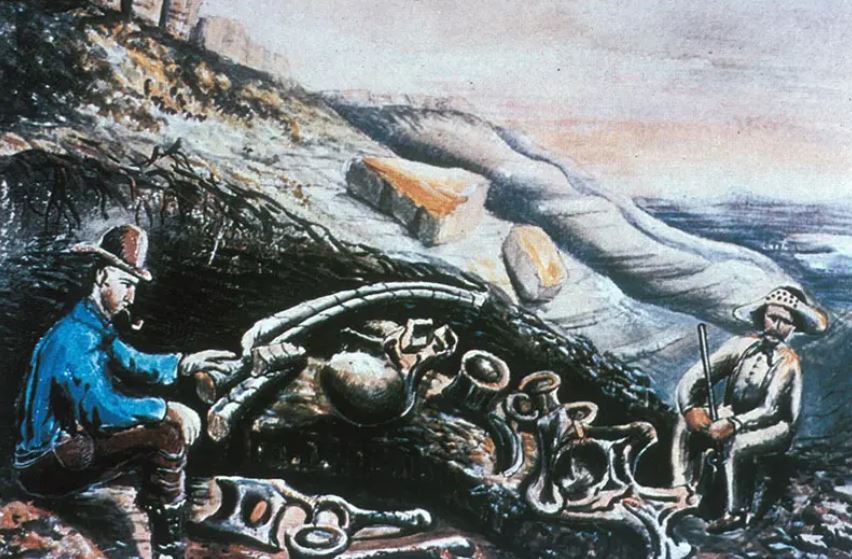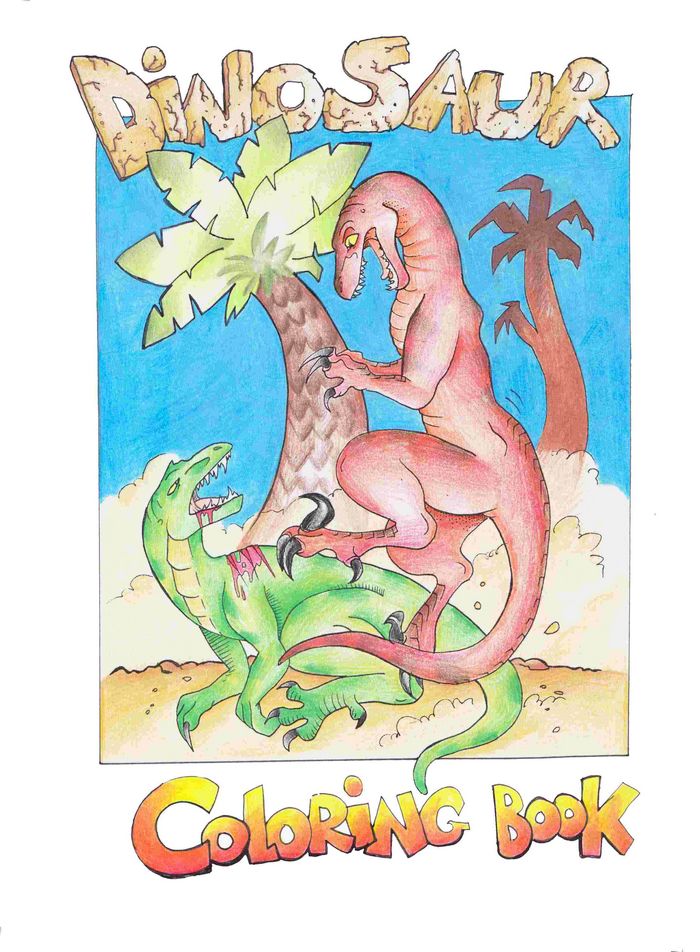The Morrison Formation is the greatest treasure trove of dinosaurs ever found. If you were to come up with a random name for any one of the iconic dinosaurs, there is a good chance that it came out of the Morrison Formation. Come and explore this amazing bone bed which gave us insights into the prehistoric world of the Late Jurassic.
Feeling lazy? Watch the video instead.
Imagine a vast plain stretching as far as the eye can see. In the west, soaring peaks tower above those low-lying plains, with rivers tumbling out of the mountain fastness, to make their more sedate way eastward across the endless plains. Occasionally volcanoes rain their ash down upon the landscape. Lakes, fed by the gushing rivers, shimmer in the low angled sun, their shores fringed with ferns, cycads, conifers, ginkgos and horsetails.
The lakes and rivers team with fish, frogs, salamanders and newts, whilst dragonflies hold station above the languid waters. Pterosaurs patrol the Jurassic skies, and in the fringing forests and out on the plains, dinosaurs roam. Thousands of dinosaurs. This place is the Serengeti of the Jurassic, teaming with bounding life. All 1.5 million square kilometres of it, or if you will, 600 000 square miles.
the world of palaeontology changed forever
This ancient landscape became buried under younger sediment, solidified, hardened, and turned into stone. 145 million years ago, the Jurassic ticked over into the Cretaceous Period. In 1877 a palaeontologist called Arthur Lakes found a fish fossil, and then some dinosaur bones, and world of palaeontology was changed forever.
a veritable palaeontological treasure trove
The sediments that were laid down in those flood plains and lakes now lie preserved in the geological record as the Morrison Formation. The Morrison has been a veritable palaeontological treasure trove, having yielded up some of the most iconic dinosaurs ever found. There is a good chance that if you were name one any one of the classic dinosaurs it would have come from the Morrison Formation. So here is a quick list of some of the famous dinosaurs that have been found there – Allosaurus, Ceratosaurus, Torvosaurus, Camptosaurus, Ornitholestes, Stegosaurus, Ankylosaurus and a wide range of sauropods including Diplodocus, Camarasaurus, Brachiosaurus, Apatosaurus, Brontosaurus, Barosaurus, Haplocanthosaurus, and Supersaurus. So that is quite a list.

Illustration of a Serengeti-type landscape in the late Jurassic Morrison formation of North America, depicting the migration of herds of dinosaurs. Image from the Science Photo Library
the number of insults increased
It was here that the Bone Wars were fought out by those two great rivals – perhaps enemies is a better word - Othniel Charles Marsh and Edward Drinker Cope as tried to outdo each other in the number of dinosaurs they dug up and named, and the number of insults that they could come up with in both the scientific publications and the popular press. The Bone Wars is another video of its own.
The Morrison Formation is centered on Wyoming and Colorado, but also outcrops in Montana, North Dakota, South Dakota, Nebraska, Kansas, Oklahoma, Texas, New Mexico, Arizona, Utah and Idaho. It outcrops in southern Canada too, where it is known as the Kootenay Group. Seventy five percent is buried under younger rocks, making it inaccessible to geologists and palaeontologists alike. Where it was caught up in the mountain building that formed the Rocky Mountains, it was eroded away. Imagine what bones still lie there, buried deep under the younger Cretaceous cover.
It is the fundamental unit of lithostratigraphy
So diving into some geology, a geological formation is “a body of rock having a consistent set of physical characteristics or lithology, that distinguishes it from adjacent bodies of rock, and which occupies a particular position in the layers of rock exposed in a geographical region (the stratigraphic column). It is the fundamental unit of lithostratigraphy, which is the study of strata or rock layers. “ Wikipedia 2023.
the geological remnants of ancient floodplains
So the Morrison is an accumulation of Upper Jurassic sedimentary rocks, comprising mudstones, sandstones, siltstones and limestones, ranging from light grey, through greenish grey to red. And as we have already seen, it has been the most productive source of dinosaur fossils in all of North America since Arthur Lakes dug up the first fish fossil there back in 1877. Most of the fossils are to be found in the green siltstones and lower sandstones, which are the geological remnants of the ancient floodplains and rivers which we met at the start of this video.
Radiometric dating shows that the Morrison Formation dates from 156 million years at its base, that is the oldest beds, to 147 million years at the top, which puts it in the same time frames as the Solnhofen Limestone Formation in Germany and the Tendaguru Formation in Tanzania.
At the time of the deposition of the sediments that make up the Morrison, the northern part of the supercontinent of Pangaea, known as Laurasia, had broken up, separating the continents of North America and Eurasia, with North America being located in the subtropics at that time.
now lie preserved as coal fields
To the north, the Sundance Sea, an extension of the Arctic Ocean, stretched down through Canada and into the United States. Swamps and forests grew in what is now Montana, and the trees that grew in these swamps now lie preserved as coal fields. To the south, conditions were drier and warmer, leading to the development of desert conditions, with wind blown or aeolian deposits forming sand dunes – eventually hardening to become sandstones.
grasses, flowers and some kinds of trees had not yet evolved
The fossils from the Morrison are often fragmentary, but in spite of that, they provide fantastic insights into the creatures and plants – the fauna and the flora – that lived in the Morrison Basin during the Jurassic. The climate was mostly dry, much like the African savannah of today, but because grasses, flowers and some kinds of trees had not yet evolved, the flora was very different to what we are familiar with. Conifers – pine trees – were dominant back then, along with ginkgos, cycads, tree ferns and horsetails. Much of the vegetation grew along the river banks and in the flood plains. Dinosaurs were the bosses back then, but fish, frogs, salamanders, crocodiles, turtles, lizards, pterosaurs, crayfish, clams and mammaliaforms also thrived in that diverse environment.
it was a safe and happy place for dinosaurs to live
The dinosaurs also probably hung out close to the rivers. Hundreds of dinosaur fossils have come out of the Morrison, including, as we have seen earlier, Allosaurus, Ceratosaurus, Torvosaurus, Camptosaurus, Ornitholestes, Stegosaurus, Ankylosaurus and a wide range of sauropods. For more information on Sauropods check out our blog on Brachiosaurus here. Camptosaurus embryos have also been discovered which suggests that it was a safe and happy place for dinosaurs to live and raise their young, providing sufficient resources for these creatures to thrive. The sauropods of the Morrison include Diplodocus, Camarasaurus, Brachiosaurus, Apatosaurus, Brontosaurus, Barosaurus, Haplocanthosaurus, and Supersaurus.
they would have been competing with each other
How they all got on and managed to survive together in that space is scope for additional scientific study – they must have all had their own feeding strategies to be able to coexist, otherwise they would have been competing with each other to the detriment of some of the species. Maybe when you become a palaeontologist you can work out the various feeding strategies of the Sauropods of the Morrison Formation.
Right, let's leave it there - our next blog is going to be about the famous sites where the flagship dinosaurs of the Morrison were dug up, and the characters who actually did all of the hard work. See you on the next one.
And seeing that you are here, grab yourself a copy of our free colouring book, which is full of wonderful dinosaurs and other Mesozoic creatures for you to bring back to life.






